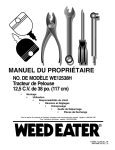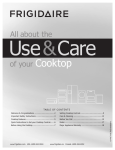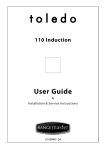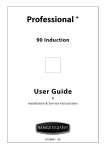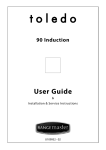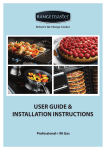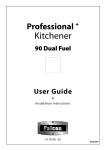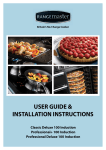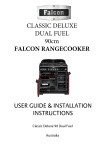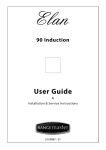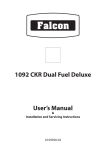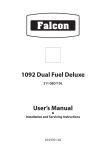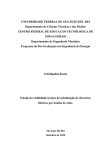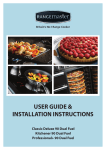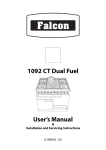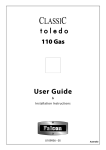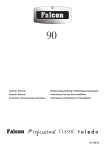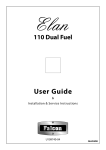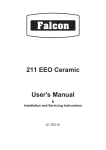Download Dual Fuel
Transcript
� ������������� ArtNo.000-0012 Professional + logo 110 Dual Fuel with FSD 110 Mixte avec DSS User Guide & Installation & Service Instructions Mode d'emploi & Instructions d'installation & d'entretier ArtNo.000-0008 Falcon logo shaded U109772-05 Contents Before you start... Cooker Overview The Griddle The Glide-out Grill The Ovens The Clock Tips on Cooking with the Timer General Oven Tips Oven Cooking Guide Oven shelves The Handyrack Main Oven Light The Browning Element Storage Cleaning your Cooker Troubleshooting Installation Conversion to LP gas Servicing Circuit Diagram Technical Data 1 2 4 5 5 6 8 8 9 10 10 11 11 11 11 13 15 21 22 26 27 Before you start... If you smell gas This appliance is designed for domestic cooking only. Using it for any other purpose could invalidate any warranty or liability claim. In particular, the oven should NOT be used for heating the kitchen - besides invalidating claims, this wastes fuel and may overheat the control knobs. • DO NOT turn electric switches on or off. • DO NOT smoke • DO NOT use naked flames • DO turn off the gas at the meter or cylinder • DO open doors and windows to get rid of the gas • DO keep people away from the area affected • Call your gas supplier. If you are using natural gas in the UK, ring the National Grid on: 0800 111 999. Installation and Maintenance Ventilation Thank you for buying the Professional + cooker. It should give you many years trouble-free cooking if installed and operated correctly. It is, therefore, important that you read this section before you start, particularly if you have not used a dual fuel cooker before. The use of a gas cooking appliance results in the production of heat and moisture in the room in which it is installed. Therefore, ensure that the kitchen is well ventilated: keep natural ventilation holes open or install a powered cooker hood that vents outside. If you have several burners on, or use the cooker for a long time, open a window or turn on an extractor fan. In the UK, the cooker must be installed by a Gas Safe registered engineer. The electrical installation should be in accordance with BS 7671. Otherwise, all installations must be in accordance with the relevant instructions in this booklet, with the relevant national and local regulations, and with the local gas and electricity supply companies’ requirements. Ensure that the gas supply is turned on and that the cooker is wired in and switched on (the cooker needs electricity). Personal Safety Set the clock to ensure that all the ovens are functional – see the relevant section in this manual. The cooker should be serviced only by a qualified service engineer, and only approved spare parts should be used. Always allow the cooker to cool and then switch it off at the mains before cleaning or carrying out any maintenance work, unless specified otherwise in this guide. Accessible parts will become hot during use and will retain heat even after you have stopped cooking. Keep babies and children away from the cooker and never wear loose-fitting or hanging clothes while the appliance is in use. Always be certain that the controls are in the OFF position when the oven is not in use, and before attempting to clean the cooker. When the oven is on, DO NOT leave the oven door open for longer than necessary – otherwise, the control knobs may become very hot. Peculiar smells When you first use your cooker it may give off a slight odour. This should stop after a little use. Cooking high moisture content foods can create a ‘steam burst’ when the oven door is opened. When opening the oven stand well back and allow any steam to disperse. Before using for the first time, make sure that all packing materials have been removed and then, to dispel manufacturing odours, turn the ovens to 200°C and run for an hour. Before using the grill for the first time you should also turn on the grill and run for 30 minutes with the grill pan in position, pushed fully back, and the grill door open. ArtNo.324-0001 Steam burst Make sure the room is well ventilated to the outside air (see 'Ventilation' below). People with respiratory or allergy problems should vacate the area for this brief period. Always keep combustible materials, e.g. curtains, and flammable liquids a safe distance away from your cooker. Do not spray aerosols in the vicinity of the cooker while it is on. Use dry oven gloves when applicable – using damp gloves might result in steam burns when you touch a hot surface. Do not use a towel or other bulky cloth in place of a glove – it might catch fire if brought into contact with a hot surface. 1 Never operate the cooker with wet hands. Do not use aluminium foil to cover shelves, linings or the oven roof. Never heat unopened food containers. Pressure build up may make the containers burst and cause injury. Do not use unstable saucepans. Always ensure that you position the handles away from the edge of the hotplate. Do not use cooking vessels on the hotplate that overlap the edges. Never leave the hotplate unattended at high heat settings. Pans boiling over can cause smoking, and greasy spills may catch on fire. Use a deep fat thermometer whenever possible to prevent fat overheating beyond the smoking point. Never leave a chip pan unattended. Always heat fat slowly, and watch as it heats. Deep fry pans should be only one third full of fat. Filling the pan too full of fat can cause spill over when food is added. If you use a combination of oils or fats in frying, stir them together before heating, or as the fats melt. Cooker Overview ArtNo.270-0014 110 Professional+ cooker The Professional + 110 Dual Fuel has the following features: • • • • • • Foods for frying should be as dry as possible. Frost on frozen foods or moisture on fresh foods can cause hot fat to bubble up and over the sides of the pan. Carefully watch for spills or overheating of foods when frying at high or medium high temperatures. Never try to move a pan of hot fat, especially a deep fat fryer. Wait until the fat is cool. Hotplate Burners Do not use the top of the flue (the slot along the back of the cooker) for warming plates, dishes, drying tea towels or softening butter. ArtNo.270-0013 110 Proplus gas hob layout Do not use water on grease fires and never pick up a flaming pan. Turn the controls off and then smother a flaming pan on a surface unit by covering the pan completely with a well fitting lid or baking tray. If available, use a multipurpose dry chemical or foamtype fire extinguisher. Take care that no water seeps into the appliance. The drawing by each of the central knobs indicates which burner that knob controls. Only certain types of glass, glass-ceramic, earthenware or other glazed containers are suitable for hotplate cooking; others may break because of the sudden change in temperature. Six hotplate burners, including a wok burner, with a FSD (Flame Safety Device) on each one. A griddle and wok cradle. A control panel. A glide-out grill. A conventional oven and a fan oven. A storage drawer. Each burner has an FSD that prevents the flow of gas if the flame goes out. This appliance is heavy, so take care when moving it. Cleaning ������� In the interests of hygiene and safety, the cooker should be kept clean at all times as a build up in fats and other food stuff could result in a fire. ��� Clean only the parts listed in this guide. Clean with caution. If a wet sponge or cloth is used to wipe spills on a hot surface, be careful to avoid steam burns. Some cleansers can produce noxious fumes if applied to a hot surface. ArtNo.311-0018 Hob burner FSD details 2 When the igniter button is pressed in, sparks will be made at every burner – this is normal. Do not attempt to disassemble or clean around any burner while another burner is on, otherwise an electric shock could result. To light a burner, press the igniter button, and push in and turn a knob to the high position indicated by the large flame symbol (): ���������������������������� You should also avoid using unstable and misshapen pans that may tilt easily, and pans with a very small base diameter, e.g. milk pans, single egg poachers. ArtNo.270-0001 Proplus control to high ArtNo.311-0004 Tipping wok The minimum recommended pan diameter is 120mm. The maximum allowable pan base diameter is 250mm. Adjust the flame height to suit by turning the knob clockwise. Wok burner ArtNo.270-0003 Proplus control to low The Wok burner is designed to provide even heat over a large area. It is ideal for large pans and stir frying. ArtNo.311-0005 Wok burner & pan support If a burner flame goes out, turn the control knob off and leave it for one minute before relighting it. For heating smaller pans, the aforementioned hotplate burners may be more efficient. Ensure that the flames are under the pans. Using a lid will help the contents boil more quickly. You can remove the burner parts for cleaning – see ‘Cleaning your cooker’. You should wipe the enamel top surface of the cooker around the hotplate burners as soon as possible after spills occur. Try to wipe them off while the enamel is still warm. Note: The use of aluminium pans may cause metallic marking of the pan supports. This does not affect the durability of the enamel and may be cleaned off with an appropriate metal cleaner. ArtNo.311-0001 Right pans gas Large pans should be spaced well apart. The Wok cradle Pans and kettles with concave bases or down turned base rims should not be used: The Wok cradle is designed to fit a Professional 35cm Wok (available from our cookware collection – Part Code RM095). If you use a different Wok, make sure that it fits the cradle. Woks vary very widely in size and shape. It’s important that the Wok sits down on the pan support – however, if the Wok is too small, the cradle will not support it properly. ArtNo.311-0002 Pan with rim Simmering aids, such as asbestos or mesh mats, are NOT recommended. They will reduce burner performance and could damage the pan supports: 3 ArtNo.311-0006 Correct wok sizes DO NOT put it crossways – it will not fit properly and will be unstable. DO NOT put it on the Wok burner on the left-hand Rapide burner – it is not designed to fit the end pan supports. The cradle should be used on the triple ring Wok burner only. When you fit the cradle, check that the Wok is properly located on the front and rear fingers and that it is supported properly on a pan support. ArtNo.090-0005 Positioning the griddle Position the griddle over the hotplate burners resting on the pan support. Check that it is securely located. ArtNo.311-0009 Oil on griddle ArtNo.311-0007 Wok stand close-up Make sure that the cradle is stable and that the Wok is sitting level in the ring. The cradle will get very hot in use – allow plenty of time for it to cool before you pick it up. The griddle can be lightly brushed with cooking oil before use. Light the hotplate burners. Adjust the flame heights to suit. The Griddle ArtNo.301-0003 Clock display at 5mins ArtNo.110-0013 Positioning the griddle on hotplate (right) Preheat the griddle for a maximum of 5 minutes before adding food. Leaving it longer may cause damage. Turn the control knobs towards the low position, marked with the small flame symbol, to reduce the burner flames. The griddle fits the centre left pan support, front to back. It is designed for cooking food on directly. Don’t use pans of any kind on it. The griddle surface is non-stick and metal cooking utensils (e.g. spatulas) will damage the surface. Use heat resistant plastic or wooden utensils. ArtNo.311-0008 Griddle positioning ArtNo.110-0014 Positioning the griddle on hotplate (wrong) Always leave space around the griddle for the gases to escape. Never fit two griddles side by side. 4 The Glide-out Grill The Ovens Open the door and pull the grill pan carriage forward using the handle: The clock must be set to the time of day before the righthand oven will work. See the following section on ‘The Clock’ for instructions on setting the time of day. References to 'left-hand' and 'right-hand' ovens apply as viewed from the front of the appliance. The left-hand oven is a conventional oven (see below), while the right-hand oven is a fanned oven that can be timed. The Left-Hand Oven ArtNo.331-0001Grill pan pulled forwards The grill has two elements that allow either the whole area of the pan to be heated or just the right-hand half. Adjust the heat to suit by turning the knob. To heat the whole grill, turn the knob clockwise: ArtNo.270-0004 Proplus grill control 0 ArtNo.322-0002 Conventional oven The left-hand conventional oven is fitted with two heating elements, one visible in the top of the oven and the second under the oven base. Be careful to avoid touching the top element and element deflector when placing or removing items. 1 2 2 1 The Right-Hand Oven 3 3 To heat the right-hand half, turn it anticlockwise. The neon indicator light by the grill control will come on. For best results, you should slide the carriage back into the grill chamber and preheat the appropriate part(s) of the grill for two minutes. The grill trivet can be removed and the food placed on it while you are waiting for the grill to preheat. Once the grill has preheated, slide the carriage out again. With the trivet back in place with the food on it, slide the carriage back into the grill chamber. Ensure that it is pushed right in. ArtNo.321-0002 Fan assisted oven This oven circulates hot air continuously, which means faster, more even cooking. The recommended cooking temperatures for a fanned oven are generally lower than for a non-fanned oven. Accessible parts may be hot when the grill is in use. Young children should be kept away. Turn the particular oven knob to the desired temperature: The grill pan grid can be turned over to give two grilling positions: ArtNo.270-0005 Proplus electric oven control 0 ArtNo.331-0002 Grill pan high/low position 0 10 140 Never close the grill door when the grill is on. 5 180 22 0 Don’t leave the grill on for more than a few moments, without the grill pan underneath it. The Clock The oven indicator light will glow until the oven has reached the temperature you selected. It will then cycle on and off during cooking: Setting the time of day ArtNo.270-0006 Proplus oven control light 0 140 10 0 220 18 ArtNo.300-0004 2-button clock annotated 0 � When cooking foods with high water content, there may be some steam visible at the grille at the rear of the hotplate. This is perfectly normal. � A – Timer knob, B – Adjusting knob When the clock is first connected, the display flashes ( 0.00) and ( ) alternately. ArtNo.110-0007 110 Oven steam out of back To set the time, turn and hold the Timer knob to the clock symbol () and at the same time turn the Adjusting knob left or right until the clock shows the time of day. Remember this is a 24-hour clock. Let go of the Timer knob and it will spring back to the vertical, oven manual setting. Minute Minder Turn the Timer knob to the right to the () minute minder setting – it should click into position: ArtNo.300-0005 2BC minute minder setting Use the Adjusting knob to set the time you need as below: ArtNo.300-0006 2BC minute minder setting 2 You can either turn the knob back to the vertical manual setting () to keep an eye on the time of day, or leave it in the () minute minder position as the time ticks down. To stop the beeper when it sounds, turn the Adjusting knob anticlockwise. 6 To stop the oven at a specific time of day Turn the Timer knob to the () position. The display will show the current time of day plus the ‘cook time’ you just set. Use the Adjusting knob to set the ‘stop time’ you need: Turn the Timer knob to the () position. ArtNo.301-0007 2BC Stopping the oven 1 ArtNo.301-0008 2BC Stopping the oven 2 Use the Adjusting knob to set the time at which the oven is to stop. You can set the oven to turn on at any time over the following 24-hour period. AUTO shows in the display: The ‘stop time’ is displayed, followed by 'AUTO'. Set the oven(s) to the cooking temperature you need Turn the Timer knob to the ‘Auto’ setting. ArtNo.301-0008 2BC Stopping the oven 2 When your cooking is finished, the beeper sounds. Turn the Timer knob to the vertical () to return to manual cooking. If you are out, don’t worry about the beeper going off – it stops on its own after a while. When you return, turn the Timer knob to the vertical () to return to manual cooking. AUTO is showing, but you want to revert to manual cooking Turn the Timer knob to the bottom ‘Auto’ setting. Once the set time is reached, the beeper sounds. Turn the Timer knob to the vertical () to return to manual cooking. You can cancel any automatic settings by briefly turning the Timer knob to the clock symbol () and then releasing it. To start and then stop the oven using the Timer Key Lock Before you set the clock, decide on both the ‘cook time’, which is the period of time you want the oven to cook, and the ‘stop time’, which is the time of day at which you want the oven to stop cooking. When the key lock is activated, the left-hand oven can be operated as usual but the right-hand oven is locked and will not come on. You cannot set a start time directly – this is set automatically by a combination of the 'cook time' and 'stop time'. Make sure that the clock is in manual mode and cancel any active programs. To activate the key lock Turn and hold the Timer knob to the clock symbol () for about 8 seconds. ‘On’ appears on the display: Turn the Timer knob to the () position: ArtNo.301-0009 2BC Setting the cooking timer Art No. 301-0011 2BC Activating the key lock 1 Use the Adjusting knob to set the ‘cooking time’ you need: Keep holding the Timer knob turned to the clock symbol () and turn the Adjusting knob clockwise until the key symbol () and ‘Of’ shows on the display. Let go of the knobs. ArtNo.301-0010 2BC Setting the cooking time ArtNo.301-0012 2BC Activating the key lock 2 7 The oven is now locked, as is confirmed by the display showing the time of day alongside the key symbol: Tips on Cooking with the Timer If you want to cook more than one dish, choose dishes that require approximately the same time. However, dishes can be ‘slowed down’ slightly by using small containers and covering them with aluminium foil, or ‘speeded up’ slightly by cooking smaller quantities or placing them in larger containers. ArtNo.301-0013 2BC Activating the key lock 3 Very perishable foods such as pork or fish should be avoided if a long delay period is planned, especially in hot weather. When the key lock is activated, the left-hand oven can be operated as usual but the right-hand oven is locked and will not come on. To turn off the key lock Turn and hold the Timer knob to the clock symbol () for about 8 seconds. ‘Of’ will appear on the display. Do not place warm food in the oven to be timed. Do not use a timed oven that is already warm. Do not use the timed oven if the adjoining oven is already warm. Whole poultry must be thoroughly defrosted before being placed in the oven. Check that meat and poultry are fully cooked before serving. ArtNo.301-0014 2BC Deactivating the key lock 1 General Oven Tips The wire shelves should always be pushed firmly to the back of the oven. Keep holding the Timer knob turned to the clock symbol () and turn the Adjusting knob clockwise until the key symbol () goes out on the display and ‘On’ shows. Let go of the knobs. Baking trays, meat tins, etc., should be placed level in the middle of the oven’s wire shelves. Keep all trays and containers away from the sides of the oven otherwise overbrowning of the food may occur. ������������������� ��������������������������� For even browning, the maximum recommended size for a baking tray is 340mm by 340mm. After a few seconds, the display reverts to showing the time of day: ArtNo.301-0016 2BC Deactivating the key lock 3 The oven can now be used normally. Always leave a ‘fingers width’ between dishes on the same shelf. This allows the heat to circulate freely around them. The Cook & Clean oven liners (see 'Cleaning your Cooker') work better when fat splashes are avoided. Cover meat when cooking. To reduce fat splashing when you add vegetables to hot fat around a roast, dry them thoroughly or brush lightly with cooking oil. If you want to brown the base of a pastry dish, preheat a baking tray for 15 minutes before placing the dish in the centre of the tray. Where dishes may boil and spill over during cooking, place them on a baking tray. ���������������������� ��������������������� � ��������� � ��������� � ��������� � ��������� � ��������� � ��������� � ��������� � ��������� ArtNo.050-0006 Gas temperature conversion table Temperature conversion table 8 Oven Cooking Guide The oven control settings and cooking times given in the table below are intended to be used only as a guide. Individual tastes may require the temperature to be altered to provide a preferred result. Top When baking in the right-hand fanned oven, use the minimum cooking time shown in the table. Food is cooked at lower temperature in a fan oven than in a conventional oven. When using recipes, reduce the temperature by 10°C and the cooking time by 5-10 minutes. The temperature in the fanned oven does not vary with height in the oven so you can use any shelf. Centre ArtNo.050-0007 Oven shelf positions Base Oven Shelf Positions Conventional Oven Fan Oven Temperature Shelf Temperature Food ArtNo.050-0003A - Cooking table - electric & fan °C position °C 160 C 150 200 C 190 160 C 150 200 C 190 160 C 150 200 C 190 160 C 150 20-25 minutes per 500g +20-25 minutes. 200 C 190 15-20 minutes per 500g +15-20 minutes. 160 C 150 20 minutes per 500g +20 minutes. 200 C 190 15 minutes per 500g +15 minutes. 160 C 150 25-30 minutes per 500g. 200 C 190 20 minutes per 500g. 140-150 C 130-140 220 T 210 Large tins 30-35 minutes; individual 10-20 minutes. Fillet 190 C/B 180 15-20 minutes. Whole 190 C/B 180 15-20 minutes per 500g. Steak 190 C/B 180 Steaks according to thickness. 140 C/B 130 45-50 minutes per 500g of mixture. Fruit 180 mm tin 150 C/B 140 2-2½ hours. Fruit 230 mm tin 150 C/B 140 Up to 3½ hours. Madeira 180 mm 160 C 150 80-90 minutes. Queen cakes 190 C 180 15-25 minutes. Scones 220 C 210 10-15 minutes. 180 mm tin 180 C 170 20-30 minutes. 210 mm tin 180 C 170 30-40 minutes. Shortcrust tarts 200 C 190 20-30 minutes on a preheated tray. Fruit pies 200 C 190 35-45 minutes. Tartlets 200 C 190 10-20 minutes according to size. Puff pastry 230 C 220 20-40 minutes according to size. Meringues 100 C 90 2-3 hours. Baked egg custard 160 C 150 45-60 minutes. Baked sponge pudding 190 C 180 40-45 minutes. 140-150 C/B 130-140 220 C/T 210 Meat Approximate cooking time ArtNo.050-0001 Gas cooking table Beef (no bone) Lamb Pork Poultry Chicken Turkey Duck Casserole Yorkshire pudding 30-35 minutes per 500g +30-35 minutes. Thoroughly thaw frozen joints before cooking. Meat may be roasted at 20-25 minutes per 500g +20-25 minutes. 220°C (210°C for fan oven) and the 30-35 minutes per 500g +30-35 minutes. cooking time adjusted accordingly. 25-30 minutes per 500g +25-30 minutes. For stuffed and rolled meats, add approximately 10 minutes per 500g, 35-40 minutes per 500g +35-40 minutes. or cook at 200°C (190°C) for 20 25-30 minutes per 500g +25-30 minutes. minutes then 160°C (150°C) for the remainder. 2-4 hours according to recipe. For stuffed poultry, you could cook at 200°C (190°C) for 20 minutes then 160°C (150°C) for remainder. Do not forget to include the weight of the stuffing. For fresh or frozen prepacked poultry, follow instructions on the pack. Thoroughly thaw frozen poultry before cooking. Fish Cake Very rich fruit - Christmas, wedding, etc. Victoria sandwich Using the conventional oven: when two tier cooking leave at least one runner space between shelves. Position the baking tray with the front edge along the front of the oven shelf. Up to three tiers can be cooked in a fan oven at the same time but make sure to leave at least one runner space between each shelf being cooked on. Desserts Milk pudding Bread 2 to 3 hours. 20-30 minutes. 9 Using the conventional oven: for even browning the maximum size of baking tray recommended is 340mm x 340mm. This ensures free heat circulation. If cooking a two tier load, the trays should be interchanged approximately halfway though the cooking time. Oven shelves The Handyrack The maximum weight that can be held by the Handyrack is 5.5kg (12lb). It should only be used with the supplied roasting tin, which is designed to fit the Handyrack. Any other vessel could be unstable. � Additional roasting tins are available from our cookware collection – Part Code RM027. ArtNo.320-0009 Oven shelf � � � A - Top view, B - Side view, C - Shelf guard, D - Front The shelf guard should be at the back pointing upwards In addition to the flat shelves, some models are supplied with a drop shelf. The drop shelf increases the possibilities for oven shelf spacing. ArtNo.320-0014 Handyrack on LH door � The Handyrack fits to the left-hand Main Oven door only. Food cooking on it is easy to attend to, because it’s accessible when the door is open. ArtNo.320-0010 Flat & drop shelves It can be fitted at two different heights. One of the oven shelves must be removed and the other positioned to suit. � When the Handyrack is used in its highest position, other dishes can be cooked on the bottom shelf position or base of the oven. A - Flat shelf, B - Drop shelf The oven shelves can be easily removed and refitted. When the Handyrack is used in its lowest position, other dishes can be cooked on the second shelf position or base of the oven. Pull the shelf forward until the back of the shelf is stopped by the shelf stop bumps in the oven sides: To fit the Handyrack, locate one side of it on the door bracket: ArtNo.320-0011 Removing the shelf 1 Lift up the front of the shelf so the back of the shelf will pass under the shelf stop and then pull the shelf forward: ArtNo.320-0015 Fitting the Handyack 1 Then spring the other side out to clip it onto the other bracket. ArtNo.320-0012 Removing the shelf 2 To refit the shelf, line up the shelf with a groove in the oven side and push the shelf back until the ends hit the shelf stop. Lift up the front so the shelf ends clear the shelf stops, and then lower the front so that the shelf is level and push it fully back. ArtNo.320-0016 Fitting the handyrack 2 ArtNo.320-0013 Removing the shelf 3 10 Main Oven Light Cleaning your Cooker Press the button to turn the light on: Essential Information Isolate the electricity supply before carrying out any thorough cleaning. Then allow the cooker to cool. Never use paint solvents, washing soda, caustic cleaners, biological powders, bleach, chlorine based bleach cleaners, coarse abrasives or salt. Don’t mix different cleaning products – they may react together with hazardous results. ArtNo.320-0026 - Oven light If the oven light fails, turn off the power supply before you change the bulb. See the ‘Troubleshooting’ section for details on how to change the bulb. All parts of the cooker can be cleaned with hot soapy water – but take care that no surplus water seeps into the appliance. The Browning Element We have developed a range of cleaning products that give maximum performance without damaging the enamel and painted surfaces. More information is available through either the Cookware Collection brochure supplied with your cooker or our website www.rangemaster.co.uk. Remember to switch on the electricity supply and reset the clock before re-using the cooker. The Browning Element is positioned in the top of the lefthand oven. It can be used at the end of a normal cooking period to give extra browning to au gratin dishes or give a crisper finish to meat. After the normal cooking is finished turn the left-hand oven thermostat knob clockwise to the browning position, ) on the fascia panel. indicated by ( Hotplate Burners Only the browning element will operate when the thermostat is turned to this position. The top and base cooking elements will automatically switch off. The burner heads and caps can be removed for cleaning. Make sure they are absolutely dry before replacing them. Some models have a separate trim ring, which fits on the burner head. The Single Ring Burners When refitting the burner head, ensure that the notch lines up with the electrode or hole in the base. Check that the burner head is level and that the cap is fitted centrally on the burner head: Storage � � � ArtNo.340-0001 110 drawer position The bottom drawer is for storing oven trays and other cooking utensils. It can get very warm, don’t store anything in it that may melt or catch fire. The drawer can be removed completely by pulling it right out and up. � � ArtNo.311-0013 Burner layout ArtNo.340-0002 110 removing the drawer A - Cap, B - Head, C - Notch, D - Electrode, E - Base 11 The Wok Burner The Wok Cradle The Wok burner is a little more complicated but it can also be taken apart for cleaning. Recommended cleaning materials are hot soapy water, a moistened soap pad, cream cleaner or a nylon scourer. � ArtNo.311-0014 Wok burner details Glide-out Grill The grill pan and grid should be washed in hot soapy water. After grilling meats or any foods that soil, leave to soak for a few minutes immediately after use. Stubborn particles may be removed from the grid using a nylon brush. Alternatively, the grill pan can be washed in a dish washer. � � Before you remove any of the grill parts for cleaning, ensure that they are cool, or use oven gloves. The grill pan can be easily removed for cleaning as follows. Remove the grill pan support frame by pulling the grill pan forward: � � Wok burner A - Inner burner cap, B - Outer burner cap, C - Inner burner head, D - Outer burner head, E - Wok burner base ArtNo.331-0001Grill pan pulled forwards When reassembling the Wok burner, turn over the large base ring and find the ‘D’ shaped area: Lift the grill pan clear of the support frame. The support frame is held to the side rails by two clips on each side: ��� ArtNo.331-0003 Grill frame out, no pan ArtNo.311-0015 Burner alignment Turn the head until the ‘D’ matches the one on the burner base. Turn the head over and place it on the burner base. To fit the small inner burner, find the larger electrode notch in the burner rim. Line this up with the white ignition electrode and place the inner burner on the large base ring. For each side, support the side rail with one hand and with the other hand lift the frame up and out of the side clips: � � ArtNo.331-0004 Removing the grill frame ArtNo.311-0016 Fitting the burner inner head For safety's sake, push the side rails back into the grill chamber. A - Electrode notch, B - Ignition electrode Now fit the two burner caps, ensuring that they are seated properly. 12 Removing the Oven Linings If you need to remove the side rails to facilitate the cleaning of the grill chamber, you can unhook them from the grill chamber sides and wipe the sides clean with a soft cloth and mild detergent. Some of the lining panels can be removed for cleaning. You will need to remove the shelves before removing the panels. Each side of the oven is fixed with four fixing screws. You don’t have to remove the screws to remove the oven linings. Simply lift each side panel upwards and they will slide off the screws. Then pull them forwards: ArtNo.331-0005 Removing the grill rail Do not use any abrasive substances. DO NOT put the side runners in a dishwasher. Once you have finished, hook the side rails back onto the sides of the chamber. To refit the frame, pull the side rails forward and, for each side in turn, support the side rail and press the frame down into the side rails. Replace the grill pan. When refitting the grill pan, ensure that the wide rim is at the front: ArtNo.320-0008 Removing the oven lining Once the linings are removed, the oven enamel interior can be cleaned. Troubleshooting Noisy oven fan. The tone of an oven fan may change as the oven heats up – this is perfectly normal. Grill not cooking properly. Are you using the pan and trivet supplied with the cooker? Is the pan being used on the runners, not the floor of the compartment? Is the grill tray pushed fully back to stop? ArtNo.331-0006 Grill pan plan Control Panel and Doors The knobs get hot when I use the oven or the grill. Can I avoid this? Avoid using any abrasive cleaners, including cream cleaners, on brushed Stainless Steel surfaces. For best results, use a liquid detergent. Yes, this is caused by heat rising from the oven or the grill, and heating them up. Don’t leave the oven door open. Make sure that the grill pan is pushed right back to the ‘back stop’ when grilling. Always grill with the grill compartment door open. The control panel and knobs, and doors, should only be cleaned with a soft cloth wrung out in clean hot soapy water. After cleaning, polish with a dry cloth. If there is an installation problem and I don’t get my original installer to come back to fix it, who pays? Ovens The ovens have removable panels that have been coated with a special enamel that partly cleans itself. This does not stop all marks on the lining, but helps to reduce the amount of manual cleaning needed. You do. Service organisations will charge for their callouts if they are correcting work carried out by your original installer. Therefore, it’s in your own interest to keep track of this installer so that you can contact them as required. The Cook & Clean panels work better above 200°C. If you do most of your cooking below this temperature, occasionally remove the panels and wipe with a lint free cloth and hot soapy water. The panels should then be dried and replaced and the oven heated at 200°C for about one hour. This will ensure the Cook & Clean panels are working effectively. Power failure. In the event of a failure in the electrical supply, remember to reset the clock to ensure that the timed oven continues to operate. DO NOT use steel wool, oven cleaning pads, or any other materials that will scratch the surface. 13 Food is cooking too slowly, too quickly, or burning. Before removing the existing bulb, turn off the power supply and ensure that the oven is cool. Open the oven door and remove the oven shelves. Cooking times may differ from your previous oven. Check that you are using the recommended temperatures and shelf positions –- see the oven cooking guide. Then adjust the settings according to your own individual tastes. Locate the bulb cover and unscrew it by turning it anticlockwise (it may be very stiff ): The oven is not cooking evenly. Do not use a baking tray with dimensions larger than those specified in the section on 'General Oven Tips'. If you are cooking a large item, be prepared to turn it round during cooking. If two shelves are used, check that space has been left for the heat to circulate. When a baking tray is put into the oven, ensure that it is placed centrally on the shelf. ArtNo.320-0019 Oven light position Now unscrew the existing bulb anticlockwise, taking care to protect your fingers with a glove in case the bulb should shatter. Check that the door seal is not damaged and that the door catch is adjusted so that the door is held firmly against the seal. A dish of water when placed on the shelf should be the same depth all over. (For example, if it is deeper at the back, then the back of the cooker should be raised up or the front lowered). If the cooker is not level arrange for your supplier to level it for you. ArtNo.324-0007 Unscrewing the bulb cover The timed oven is not coming on when turned on manually. Screw in the new bulb clockwise and then screw the bulb cover back on. Turn on the electricity supply and check that the bulb now lights. Is the power on? Is the clock illuminated? If not, there may be something wrong with the power supply. Is the cooker supply on at the isolator switch? Hotplate ignition or hotplate burners faulty. Has the time of day been set? Is the power on? Is the clock illuminated? If not, there maybe something wrong with the power supply. Is the key symbol () showing in the display to signify that the oven is locked? See the 'Clock' section of the instructions for more information on the key lock feature. Are the sparker (ignition electrode) or burner slots blocked by debris? The timed oven is not coming on when automatic cooking. Are the burner trim and caps correctly located? See the section on ‘Cleaning’. Has the oven knob been left in the OFF position by mistake? Is the oven locked (see above)? Hotplate burners will not light. Make sure that the burner parts have been replaced correctly after wiping or removing for cleaning. Oven temperature getting hotter as the cooker gets older. If turning the temperature down using the oven control knob has not worked, or has only worked for a short time, then you may need a new thermostat. This should be fitted by a service person. Check that there is not a problem with your gas supply. You can do this by making sure that other gas appliances you may have are working. Do the burners spark when you push the button? If not, verify that the power is on by checking that the clock is illuminated. The oven light is not working. The bulb has probably blown. You can buy a replacement bulb (which is not covered under the guarantee) from most electrical stores. Ask for an Edison screw fitting 15W 240V lamp, FOR OVENS. It must be a special bulb, heat resistant to 300°C. See the HELP leaflet for spares by mail order. ArtNo.324-0005 Oven light bulb 14 INSTALLATION Check the appliance is electrically safe and gas sound when you have finished. Installation Provision of Ventilation This appliance is not connected to a combustion products evacuation device. Particular attention shall be given to the relevant requirements regarding ventilation. Dear Installer Before you start your installation, please complete the details BELOW. In the UK The room containing the cooker should have an air supply in accordance with BS 5440 Part 2 : 2000. All rooms require an openable window or equivalent, while some rooms require a permanent vent in addition to the openable window. The cooker should not be installed in a bedsitting room with volume less than 20m³. If it is installed in a room of volume less than 5m³ an air vent of effective area 100cm² is required; if it is installed in a room of volume between 5m³ and 10m³, an air vent of effective area 50cm² is required; while if the volume exceeds 11m³, no air vent is required. If your customer has a problem relating to your installation they will be able to contact you easily. Installer’s Name Installer’s Company If there are other fuel burning appliances in the same room, BS 5440 Part 2 : 2000 should be consulted to determine the requisite air vent requirements. Location of Cooker Installer’s Telephone number The cooker may be installed in a kitchen/kitchen diner but NOT in a room containing a bath or shower. NOTE: You must be aware of the following safety requirements & regulations An appliance for use on LPG shall not be installed in a room or internal space below ground level. e.g. in a basement. Prior to installation, ensure that the local distribution conditions (nature of the gas and gas pressure) and the adjustment of the appliance are compatible. Conversion This appliance shall be installed in accordance with the regulations in force and only in a well ventilated space. Read the instructions before installing or using this appliance. All models are supplied set for use on group H natural gas. A conversion kit for LP gas is included with the appliance. See the instructions that are supplied with the conversion kit. After converting the appliance please attach the Gas Conversion sticker over the appropriate area of the data badge, this will identify the gas type the appliance is now set for. In the UK the regulations and standards are as follows: In your own interest and that of safety, it is law that all gas appliances be installed by competent persons. Gas Safe registered installers undertake to work to safe and satisfactory standards. Failure to install the appliance correctly could invalidate any warranty or liability claims and lead to prosecution. This appliance should not be installed in a boat or caravan. The cooker must be installed in accordance with: All relevant British Standards / Codes of Practice, in particular BS 5440 Part 2 2000 For Natural Gas – BS 6172 : 1990 and BS 6891 : 1998 For LP Gas – BS 5482-1:1994 (when the installation is in a permanent dwelling). This appliance should not be installed in a boat or caravan. The Gas Safety (Installation and Use) regulations 1998. The relevant Building / IEE regulations. 15 This appliance is designed for domestic cooking only. Use for any other purpose could invalidate any warranty or liability claim. INSTALLATION Check the appliance is electrically safe and gas sound when you have finished. Checking the parts You will need the following equipment to complete the cooker installation satisfactorily: 4 pan supports Levelling tool and Allen keys STABILITY BRACKET If the cooker is to be supplied with gas through a flexible hose, a stability bracket or chain must be fitted. ArtNo.000-0002 Classic tools ArtNo.110-0002 110 pan supports ArtNo.020-0013 Stability bracket Grill pan and trivet ArtNo.000-0003 Slide out grill pan 3 flat oven shelves and 1 drop shelf These are not supplied by with the cooker but are available at most builders’ merchants. GAS PRESSURE TESTER ArtNo.324-0002 Oven shelf ArtNo.020-0014 Gas pressure tester Handyrack FLEXIBLE GAS HOSE ArtNo.324-0003 Handyrack Must be in accordance with the relevant standards. ArtNo.324-0004 Roasting tin ArtNo.020-0015 Flexible gas hose Plinth MULTIMETER (for electrical checks) 3. 4. 5. 6. 7. 8. 9. 10. 11. Griddle ArtNo.020-0016 Multimeter You will also need the following tools: 1. 2. Roasting tin ArtNo.000-0008 Griddle Electric drill Masonry drill bit (only required if fitting the cooker on a stone or concrete floor) Wall plugs (only required if fitting the cooker on a stone or concrete floor) Steel tape measure Cross head screwdriver Flat head screwdriver 4mm & 3mm Allen keys Spirit level Pencil Adjustable spanner Screws for fitting stability bracket Wok cradle ArtNo.000-0009 Wok ring, cast 16 INSTALLATION Check the appliance is electrically safe and gas sound when you have finished. Positioning the Cooker A clearance of 130mm is required if the cooker is near a corner of the kitchen to allow the oven doors to open. The actual opening of the doors is slightly less but this allows for some protection of your hand as you open the door. The diagrams below show the minimum recommended distance from the cooker to nearby surfaces. The cooker should not be placed on a base. ���� ��� ����� ��� ���� ��� ������� ������� ����� ��� ����� ��� ArtNo.110-0005 110 door clearances Unpacking the Cooker The hotplate surround should be level with, or above, any adjacent work surface. A gap of 75mm should be left between each side of the cooker ABOVE the hotplate level and any adjacent vertical surface. Do not take any packaging off the cooker until it is directly in front of the place it is to be installed (unless it will not fit through a door in its outer packaging). Cut the banding straps and lift the cardboard box off the cooker, leaving the cooker standing on the base packaging. See the loose unpacking sheet. For non-combustible surfaces (such as unpainted metal or ceramic tiles) this can be reduced to 25mm. Moving the Cooker ArtNo.110-0035 110DF Prof+ min spacings A minimum space of 650mm is required between the top of the hotplate and a horizontal combustible surface. The cooker is very heavy. Take great care. We recommend two people manoeuvre the cooker. Ensure that the floor covering is firmly fixed, or removed to prevent it being disturbed when moving the cooker around. You will need the levelling tool. ����������� From the back tilt the cooker forward and remove the rear half of the polystyrene base pack. ��������� ArtNo.110-0003 - Min positions above cooker *Any cooker hood should be installed in accordance with the hood manufacturer’s instructions. ArtNo.010-0001 Removing the packaging Surfaces of furniture and walls at the sides and rear of the appliance should be heat, splash and steam resistant. Certain types of vinyl or laminate kitchen furniture are particularly prone to heat damage and discolouration. We cannot accept responsibility for damage caused by normal use of the cooker to any material that de-laminates or discolours at temperatures less than 65°C above room temperature. Repeat from the front and remove the front half of the poly base. Pull the drawer out to its furthest point. ArtNo.340-0002 110 removing the drawer For safety reasons curtains must not be fitted immediately behind the cooker. We recommend a gap of 1110mm between units to allow for moving the cooker. Do not box the cooker in; it must be possible to move the cooker in and out for cleaning and servicing. 17 INSTALLATION Check the appliance is electrically safe and gas sound when you have finished. Fit the levelling tool on the rectangular adjuster as shown below. ArtNo.010-0009 Pushing the cooker ���� ArtNo.010-0008 Lowering the front rollers Conversion to LP If the appliance is to be converted to LP gas do the conversion at this point. See the conversion section of these instructions. LOWER THE FRONT ROLLER by doing 14 complete (360°) turns clockwise. (This means turning and removing the levelling tool 56 times). Levelling You are recommended to use a spirit level on a shelf in one of the ovens to check for level. Now LOWER THE TWO REAR ROLLERS. First fit the levelling tool on the hexagonal adjusting nut as shown below. Place the cooker in its intended position taking care not to twist it within the gap between the kitchen units as damage may occur to the cooker or the units. The rollers can be adjusted to level the cooker. To adjust the height of the rear of the cooker use the levelling tool supplied to turn the adjusting nuts at the front bottom corners of the cooker. ArtNo.010-0002 Rear roller nut Adjust the height of the front roller to level the cooker. Turn clockwise to raise the cooker and anticlockwise to lower. When you are satisfied with the height and level raise the front of the cooker by one turn of the front roller adjuster. Screw down the front feet to meet the floor. Screw the front roller adjuster anticlockwise to raise the front roller so that the front of the cooker is supported on the feet, not the front roller, to prevent accidental movement of the cooker. Make 10 complete (360°) turns clockwise. (This means turning and removing the levelling tool 20 times). Leave the levelling tool on the adjuster with the handle of the tool facing the rear of the cooker, so that the customer can use it if they wish to move the cooker. Replace the drawer by locating on side runners and push in. ArtNo.010-0003 Lowering the rear rollers x10 Make sure you lower BOTH REAR ROLLERS. There are two adjusting nuts, one for each roller, at both the front bottom corners of the cooker. Unfold the rear edge of pack base tray. Carefully push the cooker backwards out of the base pack. Push the cooker close to its final position, leaving just enough space to get behind it. 18 INSTALLATION Check the appliance is electrically safe and gas sound when you have finished. Fitting a stability bracket flexibility in the positioning of the bayonet and make moving the cooker easier. The hose should be fitted so that both inlet and outlet connections are vertical so that the hose hangs downwards. A stability bracket or chain (not supplied by with the cooker) should be fitted when the cooker is connected to a flexible gas supply. The connector is located just below the hotplate level at the rear of the cooker. When fitting a stability bracket read these instructions together with the leaflet supplied with the bracket. � ��� � ��� � ��� ��� ����� � ArtNo.110-0010 Fitting the stability bracket ����� ArtNo.110-0011 110 DF gas hose connections ����� � � A - Levelling rollers, B - Levelling feet, C - Wall face, D - Pencil line on the floor A - Appliance gas inlet , B - Position for gas supply connector; alternatively, connect it from the side ArtNo.020-0013 Stability bracket 1. 2. 3. 4. 5. 6. Place the cooker in its intended position and level it. Draw a pencil line 100mm from the front edge of the levelling feet. Mark the centre line for the bracket by measuring 550mm from the left-hand side of the cooker. Lower the front roller and move the cooker forward. Measure back from the pencil line 550mm to locate the front edge of the bracket. Fix the bracket to the floor. Measure the height from floor level to engagement edge in back of cooker. Add 3mm to this dimension and assemble the stability bracket to this height. (i.e. from floor level to underside of the top member) and ensure the bracket does not foul the oven burner assembly. For Natural Gas the flexible hose must be in accordance with B.S.669. For LP Gas it should be capable of 50mbar pressure, 70°C temperature rise and carry a red stripe, band or label. If in doubt contact, your supplier. Screw connect the threaded end of the hose into the gas inlet in the underside of the connector block on the back of the cooker. After completing the gas connection, check the cooker is gas sound with a pressure test. Pressure testing The gas pressure can be measured at one of the centre hotplate burner injectors (not the Wok burner). Lift off a burner head and fit the pressure gauge to the injector. Turn on and light one of the other hotplate burners. Turn on the control knob for the burner with the pressure gauge fitted to let gas through. Gas Connection Must be in accordance with the relevant standards. A hose is not supplied by with the cooker. Hoses may be purchased at most builders’ merchants. Pressures Natural Gas The Gas supply needs to terminate with a down facing bayonet. The rear cover boxes limit the position of the supply point. 20mbar LP Gas cookers Butane 29mbar Propane 37mbar Turn off the burners. Reassemble burner top, making sure it is reassembled in the correct way on the burner body. Because the height of the cooker can be adjusted and each connection is different it is difficult to give precise dimensions. Ideally the house supply bayonet should be in the shaded area shown in the diagram. Although a 900mm hose can be used, a 1250mm hose will allow slightly more 19 INSTALLATION Check the appliance is electrically safe and gas sound when you have finished. Electrical Connection Hotplate This appliance must be installed by a qualified electrician to comply with the relevant Institute of Electrical Engineers (I.E.E.) regulations and also the local electricity supply company requirements. Check each burner in turn. Push in tap and turn to the large flame symbol. Press ignition switch on fascia panel. Set the clock to the time of day. Oven check WARNING: THIS APPLIANCE MUST BE EARTHED When the clock is first connected the display will flash ( 0.00) ) alternately. and ( Note: The cooker must be connected to the correct electrical supply as stated on the voltage label on the cooker, through a suitable cooker control unit incorporating a double pole switch having a contact separation of at least 3mm in all poles. The cooker must not be connected to an ordinary domestic power point. ArtNo.300-0002 2-button clock set TOD L N To set the clock to read the time of day turn and hold the Timer knob to the clock symbol () and at the same time turn the Adjusting knob left or right until the clock shows the time of day. Remember this is a 24-hour clock. Let go of the Timer knob and it will spring back to the vertical oven manual setting. ArtNo.000-0010 Electrical connections single-phase Turn on the oven and check that the oven fan starts to turn and that the oven starts to heat up. Turn off the oven. 6mm 2 230Vac 50Hz L N Fitting the plinth Loosen the 3 screws along the front bottom edge of the cooker. Hook the central keyhole over the central screw. Twist and fit each end keyhole over their respective screws. Tighten the fixing screws. Single-phase L1 N L3 L2 6mm 2 ArtNo.110-0001 - Securing the 110 plinth ArtNo.000-0011 Electrical connections 3-phase 3N ac 230/400V 50Hz L1 L2 L3 N Three-phase Access to the mains terminal is gained by removing the electrical terminal cover box on the back panel. Connect the mains cable to the correct terminals for your electrical supply type (see fig.). Check that the links are correctly fitted and that the terminal screws are tight. Secure the mains cable using the cable clamp. Customer care Current Operated Earth Leakage Breakers Thank you. Please complete your details in this Guide, inform the user how to operate the cooker and hand over the Instructions. Where the installation is protected by a 30 milliamp sensitivity residual current device (RCD), the combined use of your cooker and other domestic appliances may occasionally cause nuisance tripping. 20 INSTALLATION Check the appliance is electrically safe and gas sound when you have finished. Conversion to LP gas Clear the holes from the inner panel and pull the control panel forward: Check in the 'Technical Data' section at the back of the instructions that the cooker is convertible to the gas you want to use. This conversion must be performed by a competent person, in accordance with these instructions and with the local supply company requirements. 1 2 ArtNo.311-0011 Fitting the top panel 3 Failure to convert the appliance correctly could invalidate any warranty or liability claims and lead to prosecution. Take care not to damage or strain the wiring. Th conversion instructions must be used in conjunction with the rest of the appliance instruction, in particular for information on Standards, cooker positioning, connection, hose suitability etc. Turn the bypass screw on each control clockwise to the stop: To convert to LP gas When servicing or replacing gas-carrying components, disconnect from the gas before starting, and check that the appliance is gas sound after completion. Tap bypass screw � ArtNo.311-0012 Tap bypass screw Do not use reconditioned or unauthorised gas controls. Disconnect from the electricity supply before commencing servicing. Before electrical reconnection, check that the appliance is electrically safe. Injectors Standard burner Refit the control panel. Locate the holes on the top edge onto the tags on the inner panel, and replace the fixing screws in the bottom edge. Wok burner (some models only) Affix Label � Stick the LP gas label over the natural gas part of the appliance data label. � ArtNo.311-0010 Injectors Pressure Testing � A - Jet, B - Internal injector, C - External injector Remove burner caps and heads. Remove old jets. Fit the new jets (see Technical Data section at the back of the book for correct jets). Reassemble in reverse order. Tap Adjustment Disconnect from the electricity supply. Pull off all the control knobs. Open the grill and right hand oven doors and remove the 4 fixing screws underneath the control panel. The control panel should drop down slightly. It is held at the top by two holes on the top edge, one at each end, that locate onto tags on the inner panel. 21 Ensure that the appliance is gas sound (refer to 'Pressure Testing' earlier in the section). Check the operation of all the burners. WARNING - SERVICING TO BE CARRIED OUT ONLY BY AN AUTHORISED PERSON Disconnect from electricity and gas before servicing. Check appliance is safe when you have finished. Servicing Taking care not to damage the burner electrodes, carefully lift the hotplate, from underneath disconnect the earth lead at the right-hand rear from the rear cross member and withdraw the hotplate. BEFORE SERVICING ANY GAS CARRYING COMPONENTS. TURN OFF THE GAS SUPPLY Reassemble in reverse order ensuring that the leads are reconnected. Take care not to damage the ignition electrodes of the burners. Check the appliance is gas sound after completion of service. When checking for gas leaks do not use washing up liquid – this can corrode. Use a product specifically manufactured for leak detection. It is important that the rear earthing leads are replaced when the fixing screws are refitted as they from part of the cooker earthing. Do not use reconditioned or unauthorised gas controls. Check for correct burner operation. Disconnect from the electricity supply before servicing, particularly before removing any of the following: control panel, side panels, hotplate tray or any electrical components or covers. 3. Disconnect from the electricity supply. Remove the Control Panel (see 1). Pull the cooker forward. Remove the four retaining screws for each panel (1 at the front base, one on the top and two at the rear). Before electrical reconnection, check that the appliance is electrically safe. 1. Reassemble in reverse order. To Remove the Control Panel 4. Disconnect from the electricity supply. Remove the Control Panel (see 1). Open the grill and right-hand oven doors and remove the four fixing screws underneath the control panel. Note: The old switch may be destroyed during removal. Remove the old switch from its bezel by gripping the switch body behind the control panel and twisting sharply. The switch bezel can then be removed by folding back its locking wings and pushing forward. The control panel should drop down slightly. It is held at the top by two holes in the top edge, one at each end, that locate on tags on the inner panel. Clear the control panel holes from the inner panel and pull the control panel forward. 2 ArtNo.311-0011 Fitting the top panel Fit the new bezel to the control panel by first lining up the raised key on its body with the cut-out in the control panel and pushing it in from the front. Assemble the new switch to the bezel by lining up the key sections and pushing home. Fit the new button by pushing in from the front. Replace the Control Panel in reverse order and test for correct operation. 3 5. Disconnect the wiring from the rear. To Replace the Clock Disconnect from the electricity supply. Reassemble in reverse order. When replacing leads refer to the wiring diagram. Check operation of timer. 2. To Replace the Ignition or light Switch Disconnect from the electricity supply. Pull off all the control knobs. 1 To Remove the Side Panels Remove the Control Panel (See 1). Pull off the timer control button(s). To Remove the Hotplate Remove the timer/mounting bracket assembly from the control panel by removing the fixing screws. Disconnect from the electricity supply. Remove the pan supports and burner heads. Remove the screws holding the hotplate burners to the hotplate. Remove the timer from its mounting bracket by depressing the plastic lugs on the timer case, at the same time pulling the unit forward. Remove the 4 screws holding the hotplate tray to the cooker. Reassemble in reverse order. When replacing the leads, refer to the wiring diagram. Check the operation of the timer. 6. To Replace a Thermostat Disconnect from the electricity supply. Remove the control panel and hotplate (see 1 & 2). Open the oven door. Remove the oven furniture and slide out the oven roof liner if fitted. ArtNo.110-0012 Hotplate removal For the right-hand oven, remove the thermostat phial cover (two screws). Unclip the thermostat phial from the clips in the oven back. For the left-hand oven, pull cooker forward to gain access to the cover box at the rear of the cooker. Remove the four screws securing the cover and lift clear. 22 WARNING - SERVICING TO BE CARRIED OUT ONLY BY AN AUTHORISED PERSON Disconnect from electricity and gas before servicing. Check appliance is safe when you have finished. 12. To Replace an Oven Door Feed the thermostat capillary out of the oven. Disconnect the wiring from the thermostat. Remove two screws holding thermostat to mounting panel. Fit new thermostat and reassemble in reverse order. Ensure that the phial is clipped to the oven back with the phial centrally positioned between the clips. Open the oven door. Support the door and remove the two screws securing the upper hinge and gasket to the cooker front. Remove the door from the lower hinge by lifting slightly and moving outwards. Check the operation of the thermostat. 7. Reassemble in reverse order. To Replace the Grill Controller 13. To Replace an Oven Door Outer Panel Disconnect from the electricity supply. Move the cooker forward to gain access to the sides. Remove the control panel and hotplate (see 1 & 2). Disconnect wiring from controller. Remove two screws holding controller to mounting panel. Fit new controller and reassemble in reverse order. Check for correct operation. BEFORE SERVICING ANY GAS CARRYING COMPONENTS, TURN OFF THE GAS SUPPLY. 8. To Replace the Hotplate Control Taps The door is heavy, so take care. Open the oven door slightly and remove the front panel fixing screws from the door sides (two each side). Disconnect from the electricity supply. Remove the control panel and hotplate (see 1 & 2). Unplug the FSD lead from the rear of the tap. Undo the compression fitting at the rear of the tap. Remove the fixings that secure the tap to the gas rail. Disconnect the ignition switch wiring. ArtNo.320-0002 Oven door side screws Carefully lift off the outer door panel. Remove the tap. Remove and discard the gasket seal. Fit the new gasket seal to the replacement tap. Reassemble in reverse order. Check that the appliance is gas sound. Verify the hotplate ignition. 9. Remove the door handle from the panel by unscrewing the two retaining nuts. Fit the door handle to the new panel. Fit the panel to the door. Reassemble in reverse order. To Change Hotplate Burner Injector 14. To Change the Oven Door Latch Remove burner cap and head. Remove old jet. Fit new injector. Reassemble in reverse order. Check appliance is gas sound. Remove the outer door panel (see 13). Remove screws ‘B’ that hold the latch assembly to the inner door panel. Fit the new catch and reassemble in reverse order. 10. To Replace a Hotplate Burner Electrode Verify the door operation. Lift off pan supports, remove burner cap. Remove the screw holding the electrode. Pull electrode vertically up sufficiently to grip the lead between thumb and forefinger. Pull off the electrode, but keep hold of the lead. Fit new electrode to the lead. Fix electrode in burner with screw. Replace burner cap. Check the burner ignition. Replace pan supports. 11. To Replace a Hotplate Burner Remove the hotplate tray (see 2). The burners except the right-hand wok burner are mounted on support struts. For these burners, disconnect the burner feed pipes at the burner. Remove the screws at the front and rear holding the support stru ts. Lift the strut and burners clear. The burners are fixed to the support struts with two screws. Remove the appropriate burner and fit the new one. Reassemble in reverse order. Check that the burner operation is satisfactory. � ArtNo.320-0003 Oven door latch 15. To Adjust an Oven Door Catch Keep Open oven door, slacken off the locknut at the base of the keep, and screw in or out as required until the required fit is obtained. Retighten the locking nut. ArtNo.320-0004 Oven door keep Right-hand Wok burner Disconnect the burner feed pipes at the burner. Fit the new one and reassemble in reverse order. Check that the burner operation is satisfactory. 23 WARNING - SERVICING TO BE CARRIED OUT ONLY BY AN AUTHORISED PERSON Disconnect from electricity and gas before servicing. Check appliance is safe when you have finished. 16. To Change an Oven Door Seal 19. To Change the Fan in the Right-hand Oven Open the oven door. The seal is held in place by small hooks on the rear face. At the corner, pull the seal diagonally away from the door centre until that hook is released. Proceed to the next hook and release it in a similar way, and so on. Use force if the hooks are stiff, as the old seal will be discarded. Disconnect from the electricity supply. Pull the cooker forward to gain access to the rear. Remove the screws securing the electric cover to the back sheet and remove the cover. Disconnect the three terminals connected to the fan noting their position. Remove the oven inner back (see 18). Hold the fan blade and remove the centre nut (left-hand thread) two brass washers, fan blade and Circlip. Unscrew the fan retaining nuts and washers (three off each) and lift the fan away from the rear of the cooker. Fit the new fan and reassemble in reverse order. Check the operation of the oven. 20. To Remove an Oven element Thermal Cut-Out Disconnect from the electricity supply. Pull the cooker forward to gain access to the cover box. Undo the cover screws and lift clear. The cut-out is located on the earth plate beside the oven element connections. Disconnect the cut-out wiring. Undo the fixings that secure the cut-out to the earth plate and remove. Fit the replacement control and re-assemble in reverse order. ArtNo.320-0005 Oven door rubber seal When fitting the new seal, position the seal join at the bottom. Hook the new seal in one of the corner holes of the door, and proceed round the door, snapping in each hook in turn. 21. To Remove the Right-Hand Oven Element 17. To Replace the Grill Element Disconnect from the electricity supply. Disconnect from the electricity supply. Remove oven inner back (see 18). Remove the grill pan from the grill chamber. From inside the grill compartment, remove the enamelled front shield from the grill roof, by undoing the two screws and washers. Remove two screws and washers securing the grill element front support. Remove the screws from the grill elements. Lift elements out carefully, disconnect the leads from the element terminals noting their position. If it is not possible to disconnect the leads in this way, pull cooker forward to gain access to the rear, remove screws securing the electric cover to the back sheet and remove cover and disconnect the terminals from the rear. �������������������� ArtNo.321-0005 Fan oven element Fit new elements, reassemble in reverse order. Check operation of grill. Remove the two screws from the top of the element and the one from the bottom of the element inside the oven. Lift the element out carefully, disconnecting the terminals connected to the element (noting their positions). If it is not possible to disconnect the leads in this way, pull the cooker forward to gain access to the rear, remove the screws securing the electric cover to the back sheet, remove the cover and disconnect the terminals from the rear. 18. To Remove Right-Hand Oven Inner Back Open right-hand oven door and remove the screws and washers securing the inner back to the back of the oven. Fit the new element and reassemble in reverse order. Check the operation of the oven. ArtNo.320-0020 Oven back fixing screws Carefully lift away the inner back. Reassemble in reverse order making sure that the four screws and washers are fully tightened. 24 WARNING - SERVICING TO BE CARRIED OUT ONLY BY AN AUTHORISED PERSON Disconnect from electricity and gas before servicing. Check appliance is safe when you have finished. 22. To Remove the Left-Hand Oven Bottom and Top Elements Disconnect from the electricity supply. Bottom Element Pull the cooker forward to access the cover boxes at the rear of the unit. Remove the fixings that secure the cover and lift it clear. ArtNo.322-0002 Oven bottom element access � � � Remove the two screws ‘A’ and allow the plate to drop down. Remove the two screws B, lower the upper plate and remove through the slot in the cooker back. Undo the terminal connections, noting their positions. Remove the element fixings and withdraw the element. Replace the element and re-assemble parts in reverse order. Top Element Open the left-hand oven door and undo the fixings that secure the heat shield. Remove the top element bracket fixings and withdraw element. Replace the element and reassemble parts in reverse order. Check that the oven operates satisfactorily. 23. To Adjust an Oven Door Angle The bottom hinge of either oven door can be adjusted to alter the angle of the door. Loosen the bottom hinge fixing screws and use the notch and a flat bladed screwdriver to move the position of the hinge to set the hinge position. Retighten the hinge screws. Effect of hinge adjustment – exaggerated for clarity ArtNo.320-0006 Oven door hinge adjustment 1 Centre line of hinge pin ArtNo.320-0007 Oven door hinge adjustment 2 Oven door omitted for clarity 25 Circuit Diagram � � � � �� �� �� �� � � � � � � � � � �� � � �� � � � � � � � � � �� �� �� � � �� �� �� � �� � �� � � � �� � � � � � �� � �� �� �� � �� � � � �� � �� � � �� � �� � � � �� �� � � �� f � � �� �� ������� � � � �� �� � � �� � � � � �� �� ������� � �� � � � � �� �� �� �� d e c b � a � � �� � �� �� � � � 1 2 � � � Key The connections shown in the circuit diagram are for single-phase. The ratings are for 230V 50Hz. Code Description Code Description Colour Code A1 Grill control D1 Right-hand fan oven thermostat b Blue A2 Grill element left-hand side D2 Right-hand fan oven control br Brown A3 Grill element right-hand side D3 Right-hand fan oven element bk Black B1 Left-hand oven thermostat D4 Right-hand fan oven fan or Orange B2 Left-hand oven control F1 Ignition switch r Red B3 Left-hand oven browning element F2 Ignition spark generator v Violet B4 Left-hand oven top element G1 Oven light switch w White B5 Left-hand oven base element G2 Oven light y Yellow C Clock H Neon g/y Green/yellow I Thermal cut-out gr Grey 26 � Technical Data This cooker is category II2H3+ It is supplied set for group H natural gas. A conversion kit from NG to LP gas is packed with the cooker. INSTALLER: Please leave these instructions with the User. DATA BADGE LOCATION: Cooker back, serial number repeater badge below oven door opening. Country of Destination: GB Gas (Rp ½ at rear right-hand side) Natural Gas 20mbar Butane 29mbar Propane 37mbar Electric 220 - 240V 50Hz (See appliance data badge for test pressures) Dimensions Overall height minimum 903mm maximum 930mm Overall width 1100mm; see ‘Positioning of Cooker’ Overall depth 648mm Space for fixing See ‘Positioning of Cooker’ Minimum space above hotplate 650mm Ratings Natural Gas L.P. Gas Injector Hotplate Injector internal 80 3.5kW (255g/h) internal 54 Right-hand Wok burner 3.5kW Large Burners 3.0kW 134 3.0kW (218g/h) 87 Medium Burners 1.7kW 109 1.7kW (124g/h) 68 Small Burner 1.0kW 75 1.0kW (73g/h) 51 external 129 external 77 Gas burner inputs based on Gross Calorific Value Conventional Ovens Oven Browning Element 2.2 kW 1.15kW Forced air convection 2.5 kW Energy efficiency class: on a scale of A (more efficient) to G (less efficient) A A Energy consumption based on standard load 0.99kWh 0.85kWh 67 67 Large Large 40 minutes 38 minutes 1400cm² 1400cm² Usable volume (litres) Size Time to cook standard load Surface area of the grid Grill 2.3kW Maximum total electrical load at 230V 7.1kW (approximate total including oven lights, oven fan, etc.) 27





























